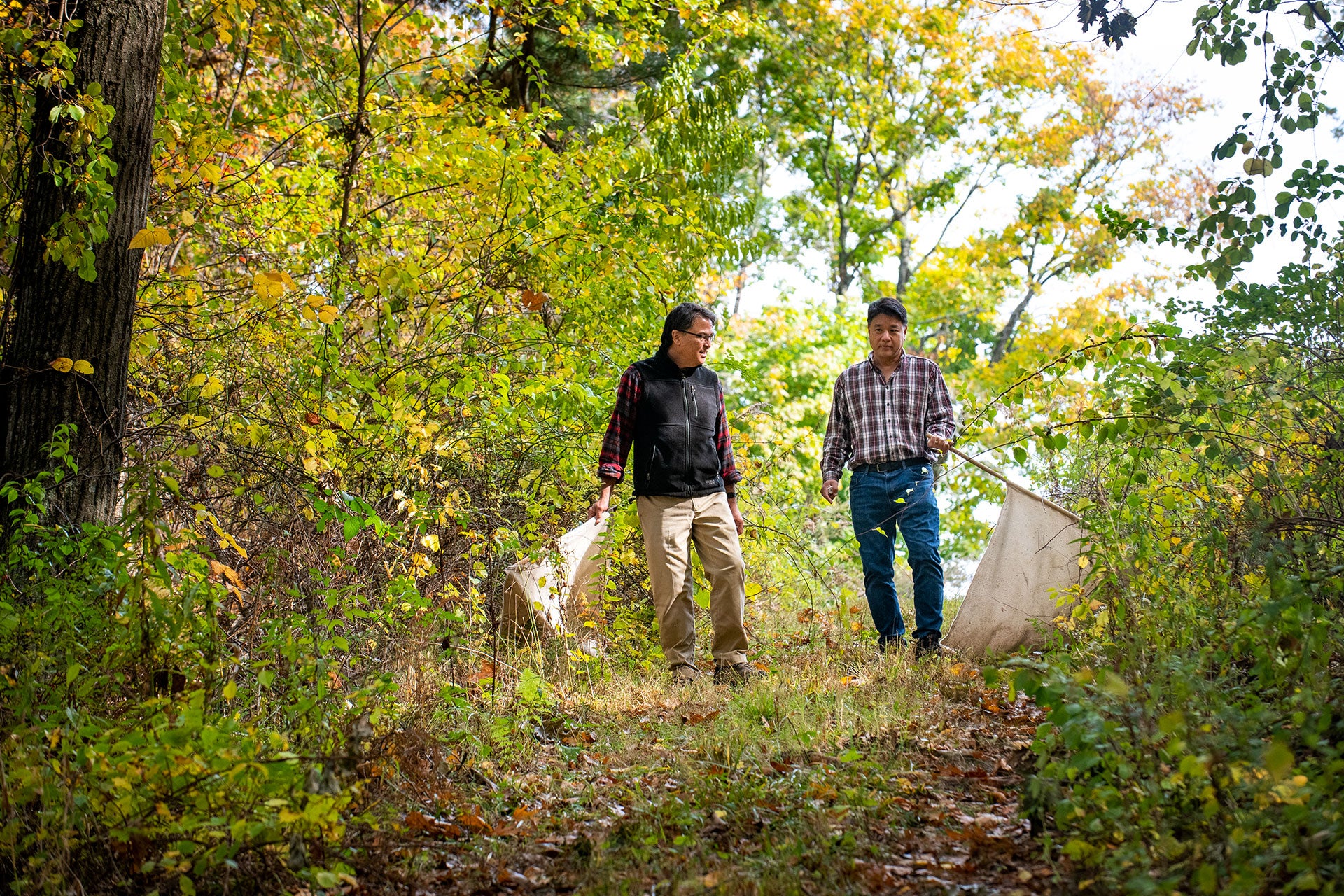TICK TALK: Tick-borne disease is on the rise
Author of the article:Liz Braun
Publishing date:Jun 03, 2021 • 1 hour ago • 3 minute read • Join the conversation
A sign warning of ticks at the entrance of a path leading to the Westminster Ponds in London, Ont. on Friday, May 28, 2021.
A sign warning of ticks at the entrance of a path leading to the Westminster Ponds in London, Ont. on Friday, May 28, 2021. PHOTO BY DEREK RUTTAN /POSTMEDIA NETWORK
Article content
It’s tick time.
Just in case COVID-19 hadn’t already provided you with enough zoonotic disease trouble for a whole lifetime, tick season is upon us and it’s time for an update on that tiny carrier of dire disease.
Ticks carry Borrelia burgdorferi — the bacteria that leads to Lyme Disease — and are getting ever more plentiful everywhere.
Once thought to be a scourge in New England states alone, Lyme-carrying ticks are turning up everywhere in North America with an assist from global warming.
This year is predicted to be a bad one for ticks with a larger population than usual; according to pests.org, blame it on warm, wet weather.
Mice, squirrels, chipmunks and migratory birds are the source of the Borrelia burgdorferi, playing host to the pathogens and passing them on to the ticks that bite them — and who then bite humans.
People who keep an eye on these things will have noticed that ticks have now been found near beaches in Northern California. Not only that, the ticks were found in the grasses and areas bordering beaches; so much for the notion that the tiny critters won’t be found near sand.
Advertisement
STORY CONTINUES BELOW
Article content
Things have increased so much here at home that there is a Lyme risk area map available now through public health Ontario.
What the map shows is that the tick trail runs up the St. Lawrence and along the Great Lakes; cottage country has not been spared.
Ticks are about the size of a poppy seed, so they can bite you and stay on your body, tucked away in a skin fold, armpit or elsewhere you might not notice them. They feed on blood — gross — and in the process spit germs into the host body.
It takes 12 to 24 hours for poison to enter the host bloodstream, which is why it’s crucial while camping or hiking to check every inch of your body twice a day.
Symptoms of a tick bite can include flu-like symptoms; if you’re lucky, a tell-tale target rash will form at the bite site.
Advertisement
STORY CONTINUES BELOW
Article content
But not everyone gets that rash.
Most people are helped immediately by antibiotics, but about 15% of those who get Lyme Disease never fully recover their health.
Ironically, COVID-19 has contributed to increases in Lyme. During lockdown, people turned to nature for exercise and adventure, and an increase in camping and hiking in the woods has exposed more people to tick bites.
COVID also inspired people to vacation in cottage country, to explore their own province and even to move to rural areas in the hunt for more space — all places where ticks can be found.
Ticks are in the cities too, of course, and in a city such as Toronto, parks and ravines should be considered areas where care must be taken.
Even a walk off-path in High Park requires the same precautions: long pants, preferably light coloured so you can see any ticks, and tuck those pants into socks so there’s no gap where ticks can attach themselves.
Wear a long-sleeved shirt, too. In deep woods, products such as Off! can be used to keep ticks at bay.
MORE ON THIS TOPIC
A Lyme disease infected tick is pictured crawling on wood in this undated file photo. (Getty Images)
Ticks: A ticking Lyme bomb
Black-legged ticks, otherwise known as deer ticks, can carry transmit Lyme disease.
Be nice to Mother Nature during pandemic and she'll reciprocate
Toronto Health Board Chair Joe Cressy speaks a press conference in in Morningside Park in Scarborough on Thursday. Joined by Toronto Public Health Associate Medical Officer of Health Dr. Christine Navarro (left) and Toronto Public Health Manager Elaine Pacheco (right) he warned Torontonians to take precautions against tick bites this summer.
TPH conducts tick surveillance for Lyme Disease prevention
There is some good news. At Tufts University in Massachusetts, there is a new initiative underway to rid the world of Lyme disease by 2030.
And Dr. Kieran Moore, Ontario’s new Chief Medical officer of Health, is part of the Canadian Lyme Disease Research Network.


 now.tufts.edu
now.tufts.edu

 smithsonianmag.com
smithsonianmag.com

 pests.org
pests.org

 torontosun.com
torontosun.com
Author of the article:Liz Braun
Publishing date:Jun 03, 2021 • 1 hour ago • 3 minute read • Join the conversation
A sign warning of ticks at the entrance of a path leading to the Westminster Ponds in London, Ont. on Friday, May 28, 2021.
A sign warning of ticks at the entrance of a path leading to the Westminster Ponds in London, Ont. on Friday, May 28, 2021. PHOTO BY DEREK RUTTAN /POSTMEDIA NETWORK
Article content
It’s tick time.
Just in case COVID-19 hadn’t already provided you with enough zoonotic disease trouble for a whole lifetime, tick season is upon us and it’s time for an update on that tiny carrier of dire disease.
Ticks carry Borrelia burgdorferi — the bacteria that leads to Lyme Disease — and are getting ever more plentiful everywhere.
Once thought to be a scourge in New England states alone, Lyme-carrying ticks are turning up everywhere in North America with an assist from global warming.
This year is predicted to be a bad one for ticks with a larger population than usual; according to pests.org, blame it on warm, wet weather.
Mice, squirrels, chipmunks and migratory birds are the source of the Borrelia burgdorferi, playing host to the pathogens and passing them on to the ticks that bite them — and who then bite humans.
People who keep an eye on these things will have noticed that ticks have now been found near beaches in Northern California. Not only that, the ticks were found in the grasses and areas bordering beaches; so much for the notion that the tiny critters won’t be found near sand.
Advertisement
STORY CONTINUES BELOW
Article content
Things have increased so much here at home that there is a Lyme risk area map available now through public health Ontario.
What the map shows is that the tick trail runs up the St. Lawrence and along the Great Lakes; cottage country has not been spared.
Ticks are about the size of a poppy seed, so they can bite you and stay on your body, tucked away in a skin fold, armpit or elsewhere you might not notice them. They feed on blood — gross — and in the process spit germs into the host body.
It takes 12 to 24 hours for poison to enter the host bloodstream, which is why it’s crucial while camping or hiking to check every inch of your body twice a day.
Symptoms of a tick bite can include flu-like symptoms; if you’re lucky, a tell-tale target rash will form at the bite site.
Advertisement
STORY CONTINUES BELOW
Article content
But not everyone gets that rash.
Most people are helped immediately by antibiotics, but about 15% of those who get Lyme Disease never fully recover their health.
Ironically, COVID-19 has contributed to increases in Lyme. During lockdown, people turned to nature for exercise and adventure, and an increase in camping and hiking in the woods has exposed more people to tick bites.
COVID also inspired people to vacation in cottage country, to explore their own province and even to move to rural areas in the hunt for more space — all places where ticks can be found.
Ticks are in the cities too, of course, and in a city such as Toronto, parks and ravines should be considered areas where care must be taken.
Even a walk off-path in High Park requires the same precautions: long pants, preferably light coloured so you can see any ticks, and tuck those pants into socks so there’s no gap where ticks can attach themselves.
Wear a long-sleeved shirt, too. In deep woods, products such as Off! can be used to keep ticks at bay.
A Lyme disease infected tick is pictured crawling on wood in this undated file photo. (Getty Images)
Ticks: A ticking Lyme bomb
Black-legged ticks, otherwise known as deer ticks, can carry transmit Lyme disease.
Be nice to Mother Nature during pandemic and she'll reciprocate
Toronto Health Board Chair Joe Cressy speaks a press conference in in Morningside Park in Scarborough on Thursday. Joined by Toronto Public Health Associate Medical Officer of Health Dr. Christine Navarro (left) and Toronto Public Health Manager Elaine Pacheco (right) he warned Torontonians to take precautions against tick bites this summer.
TPH conducts tick surveillance for Lyme Disease prevention
There is some good news. At Tufts University in Massachusetts, there is a new initiative underway to rid the world of Lyme disease by 2030.
And Dr. Kieran Moore, Ontario’s new Chief Medical officer of Health, is part of the Canadian Lyme Disease Research Network.


Plotting the End of Lyme Disease
The Tufts Lyme Disease Initiative seeks to eradicate the disease once and for all.

California Study Finds Lyme Disease-Carrying Ticks by the Beach
Researchers found as many ticks carrying the bacterium that causes Lyme disease in coastal areas as they did in woodlands

2021 Tick Forecast - Updated for February 14, 2023 - Pests.org
Ticks can be nuisances and can be real threats to human health. Check out our Tick Forecast to learn how to get ahead of the season.

TICK TALK: Tick-borne disease is on the rise
Tick season is upon us and it’s time for an update on that tiny carrier of dire disease.